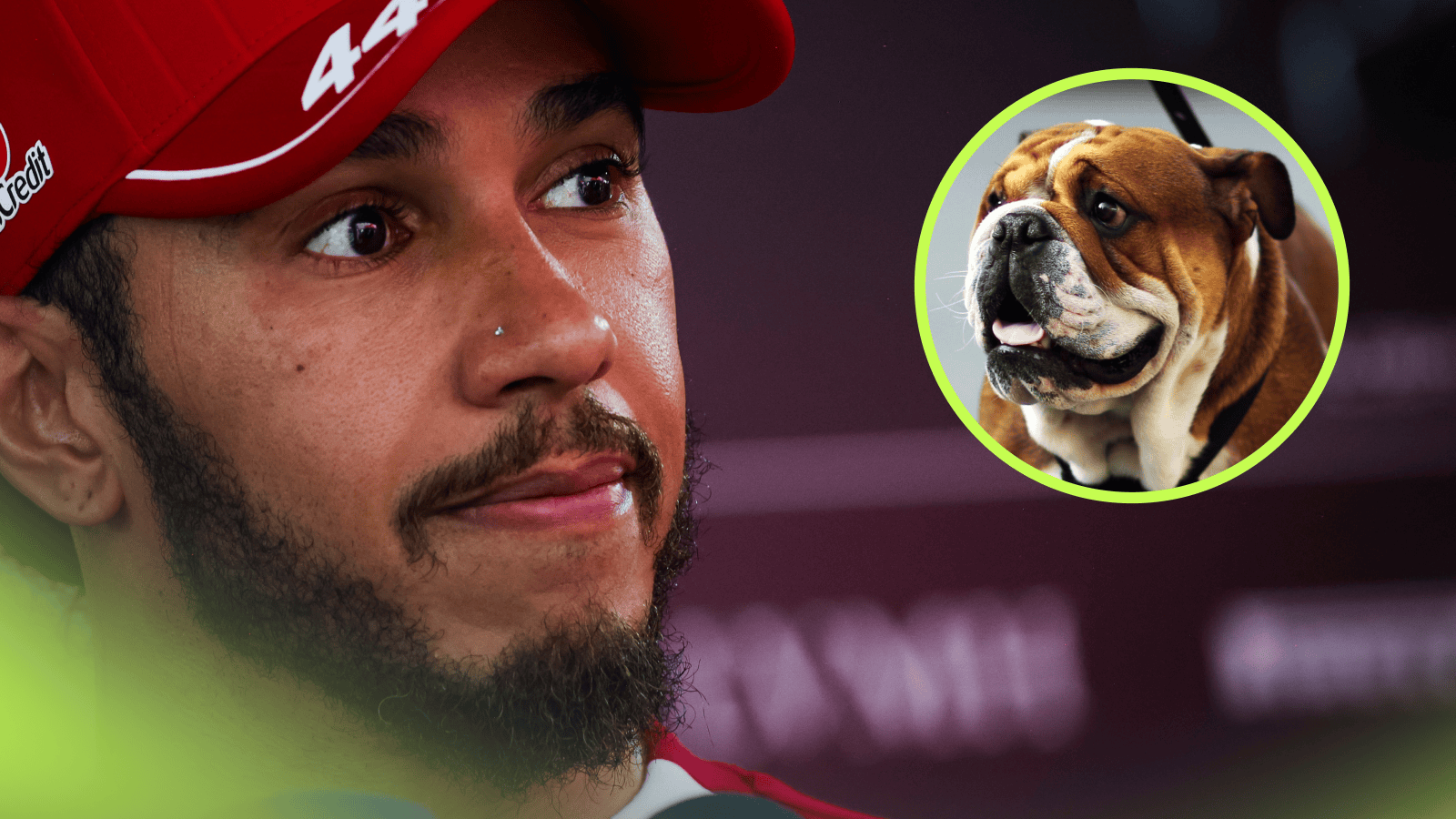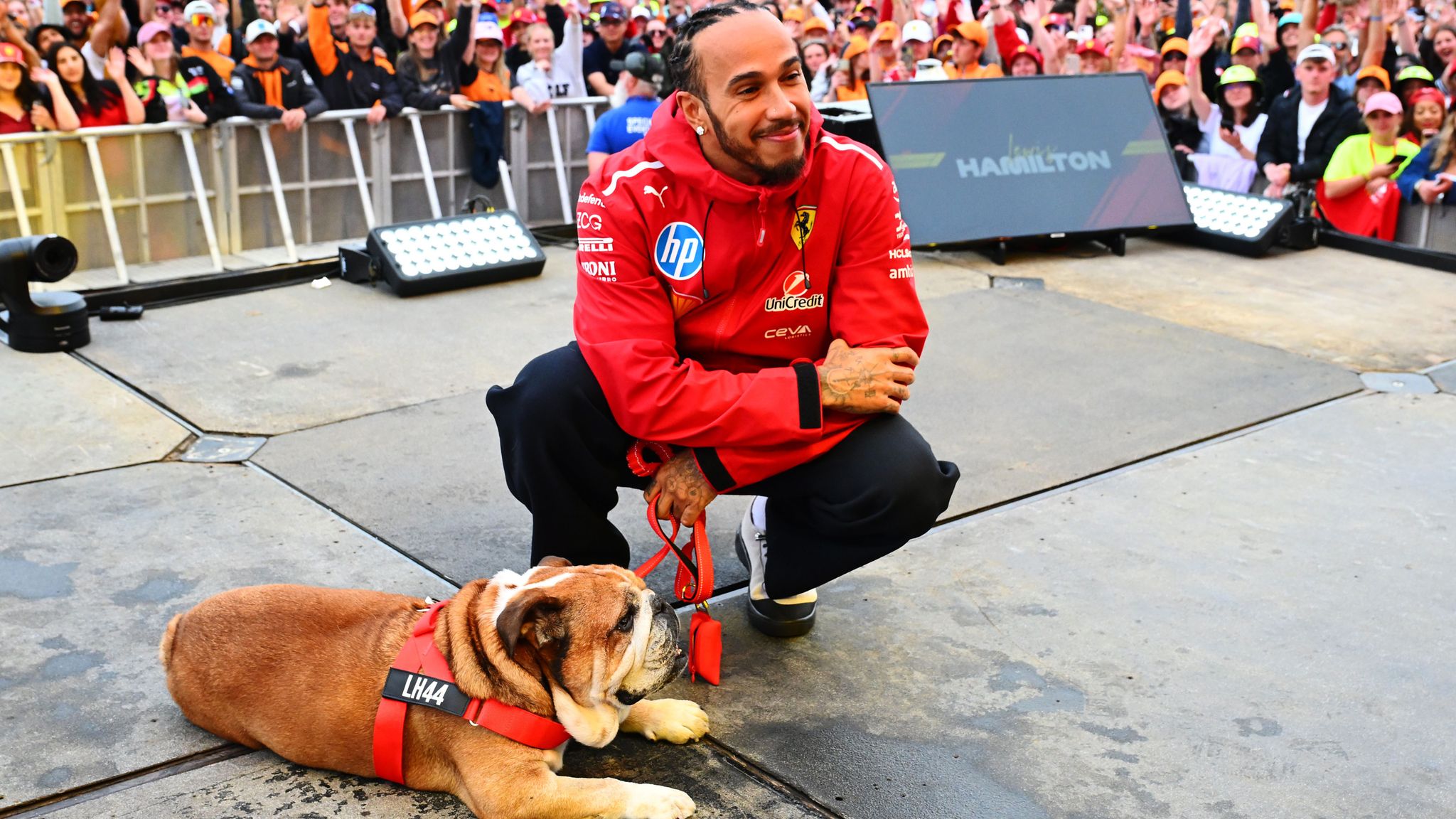Maranello, Italy – The news hit the Formula 1 world not with the roar of an engine, but with the quiet, devastating sadness of a personal crisis. When Lewis Hamilton’s heart momentarily stopped—not from the G-forces of a high-speed corner, but while standing vigil over his dearest companion in a veterinary hospital—the ripple effect immediately halted the critical development schedule of Scuderia Ferrari.
The tragic situation surrounding the 12-year-old bulldog, Roscoe, is not merely a touching human-interest story; it is a profound ethical test, a potential warning sign for the seven-time world champion’s career at a pivotal crossroads, and a deep psychological blow to Ferrari’s all-important 2026 championship aspirations.
In an unprecedented display of where his true priorities lie, Hamilton withdrew from a crucial Ferrari testing session in Fiorano, where the team was slated to evaluate the foundational 2026 Pirelli tires. He effectively handed the sole responsibility for this critical development work to his teammate, Charles Leclerc.
This decision, which placed the life of his loyal dog above a core professional obligation, exposed pre-existing fissures in Hamilton’s mental armor and forced the biggest question of the season into the spotlight: Could Roscoe’s fight for life ultimately determine Hamilton’s championship hopes, and by extension, Ferrari’s future success, more than any result on the track?
The gravity of the situation is immense, both personally and professionally. This is more than a man and his dog; it’s a global superstar making a very human choice with monumental, career-defining consequences.

The Silent Crisis and the Weight of Unconditional Love
The details of the crisis are harrowing, stemming from Hamilton’s own heartfelt, vulnerable statement on social media. Roscoe’s health reached a critical point when the bulldog contracted pneumonia again and was struggling severely to breathe. The moment that truly shattered Hamilton came during medical checks at the hospital when Roscoe’s heart actually stopped beating. While veterinarians miraculously managed to revive him and restore a heartbeat, Roscoe is now in a medically induced coma. The champion admitted to the world, with palpable despair, that they “don’t know whether he will wake from this.”
The timing could not possibly be worse for the iconic Italian team. With the high-stakes Singapore Grand Prix looming just over a week away, Hamilton should be deep in preparation and mental focus. Instead, he is maintaining a desperate, heartbreaking bedside vigil. For Hamilton, Roscoe is not merely a pet; he is an indispensable emotional support animal, a silent confidant, and a faithful witness who has been by his side since 2013, present for every chapter of his extraordinary journey.
Roscoe has been a constant presence through the exhilarating transfer from McLaren to Mercedes, the six subsequent world championships, the devastating losses to Rosberg and Verstappen, and now, the immensely challenging transition to Ferrari. Roscoe has often been seen on the grid, on the podium, and in the paddock, providing a grounding force and a source of unconditional support whose value, as one source noted, “cannot be overstated.” Hamilton’s rationale, at its core, is a simple, powerful declaration: “Family first, racing second.” Yet, for a driver still fiercely chasing that record eighth title and struggling with arguably his greatest professional challenge in years, the action is fraught with complicated, far-reaching implications.
The 2026 Vacuum: Ferrari’s Development Nightmare
Hamilton’s absence from the Fiorano test is not just the loss of a driver; it is the loss of his unique, decades-spanning experience. The test was foundational, focusing on the evaluation of Pirelli tires for the 2026 regulation changes. This season represents Hamilton’s last legitimate chance to truly fight for the championship on a level playing field, as the car will be 99% changed compared to the current machinery. It is the golden opportunity for Ferrari and Hamilton to collaboratively sculpt a blank-slate machine, eradicating the structural flaws that have plagued the Scuderia for years.
Tire development is paramount in modern F1, and missing this crucial data gathering session creates a significant void in their preparatory work. While Charles Leclerc is capable, Hamilton’s specialized feedback—honed over seven world titles—is irreplaceable, particularly in the delicate initial phase of new regulation preparation. Ferrari, according to sources, has not officially specified the reason for Hamilton’s withdrawal, but the connection is unmistakable and deeply unsettling for the team hierarchy.
However, the real fear lurking among Ferrari executives transcends the single missed test. It concerns the concerning pattern emerging during Hamilton’s challenging stint with the Italian outfit. He is currently carrying an unwanted, record-breaking streak: 17 races without a podium as a Ferrari driver—the longest such streak for any Ferrari pilot in recent memory. The Roscoe crisis, though external, serves as a stress test, exposing underlying professional cracks that have been building all season.

Psychological Fallout: The Cracks Are Showing
Hamilton’s struggles at Ferrari are, fundamentally, much deeper than one missed session. His elimination in Q2 at Baku, for instance, wasn’t merely unexpected; it was symptomatic of a driver still grappling with his machinery and fighting for confidence. In his post-race analysis, Hamilton candidly admitted: “The car has been quite snappy, so I’m still not 100% confident under braking when I’m attacking on the brakes.” This crucial context amplifies why the Roscoe situation is so devastating. He is already operating on a knife’s edge of confidence, having qualified his recent comfort with the car by adding the telling admission that it’s “still not on the desired level where he could push it to a great extent.”
This timeline is critical: Hamilton’s existing issues with car confidence, compounded by Ferrari’s slip to P3 in the Constructors’ Championship and strategic missteps, were already creating immense internal pressure. Now, facing the potential loss of his closest companion during this vulnerable period, the psychological toll could be catastrophic. The data suggests this concern is valid; despite perceived progress in car development, Hamilton’s performance gap to Leclerc has been consistently growing. Even when Hamilton finished ahead in races, it has often been attributed to strategic miscommunication or team orders rather than pure, unadulterated pace.
Everything seems to be converging, creating a perfect storm where a profound personal crisis threatens to derail a professional career that is already running on a highly pressurized, fragile track.
The Singapore Litmus Test and the Question of Legacy
The upcoming Singapore Grand Prix transforms from a typical street circuit race into a brutal psychological litmus test. Can Hamilton successfully compartmentalize his anguish and deliver the elite performance Ferrari desperately requires? Or will this mark the visible beginning of a decline that casts a shadow over their entire 2026 championship preparation?
As Hamilton sits beside Roscoe’s hospital bed, facing an uncertain outcome, his prior admission that “certain things in life can wait” suggests a profound shift in priorities that extends beyond this immediate emergency. If Roscoe does not recover, Hamilton faces what sources describe as a “very troublesome period ahead of him” that will undoubtedly affect his focus and output in Singapore and beyond.
Ferrari is caught in an impossible bind. They urgently need Hamilton’s legendary experience for their 2026 development, especially given the current dominance of rivals like McLaren, which could easily translate into the new regulation era. Yet, they are managing a driver who, by his own admission, cannot push the current car to its limits and is now carrying an unimaginable emotional burden.
The most profound question remains: Does Hamilton’s willingness to prioritize personal relationships over professional obligations signal a driver who is beginning to prepare for life after Formula 1, one who is gently easing his commitment to the relentless, all-consuming machine of the sport? Or is he simply demonstrating, at the peak of his fame, what true human priorities look like—a powerful, if disruptive, statement that life and love must ultimately transcend the demands of a high-octane, high-pressure career?
The answer to this choice will not merely shape Hamilton’s personal legacy but will directly impact Ferrari’s championship chances for the foreseeable future. This is a story that goes far beyond the paddock; it is an agonizing intersection of humanity, choice, and the crushing demands of elite, global competition. Hamilton’s heartbreaking decision is a powerful reminder that even the greatest champions possess non-negotiable personal priorities, even when the potential cost is the ultimate world title. At this critical juncture, the destiny of a champion and the future of an iconic racing team hang in the balance, waiting for the fragile heartbeat of a loyal bulldog to decide their fate.
